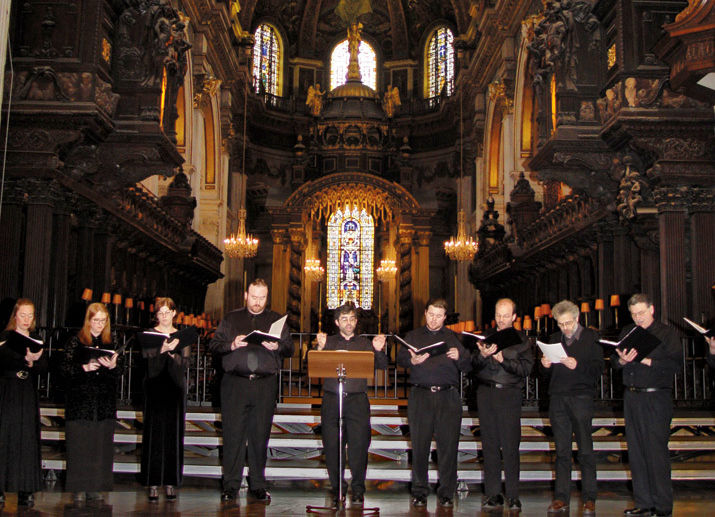Guided by Voices

Capella Romana performs in London’s St. Paul’s Cathedral at the 2004 Byzantine Festival.
Image: Steve Eck
WITH YOUR EYES CLOSED, YOU CAN ALMOST FEEL IT. The blood. The flames. The screaming. The brittle thwack of arrows against fortress walls; the wet thunk of another sharpened point finding its mark. It is the spring of 1453, and Constantinople, once the glittering capitol of the Byzantine Empire, is under siege by 80,000 Ottoman Turks.
In less than two months, the city will fall, rocking the foundation of Christendom. But as you envision the besieged metropolis, the church where voices are crying out for deliverance, you hear an altogether more ethereal sound: the harmonic trill of unaccompanied song.
Open your eyes. You’re in Portland. It’s winter. And inside the stained glass of St. Mary’s Cathedral, Cappella Romana, the world’s preeminent early-music vocal group, is giving flight to a program of ecstatic verses and Byzantine chants—just the sort that would have filled a battered church as Constantinople fell in the 15th century. Twelve men are dressed in black, their throats shaping notes with more nuances than a fine wine: the dusky warble from a Middle Eastern sacred chant, the singsong lilt of East India, the guttural brogue of the Slavic tongue, and the hushed monotones of a European monastery. As these finely tuned intersections of culture and language from Constantinople, one of the world’s great crossroads, wash through the room, they inspire a collective act of imagination from the audience. All eyes are closed.
“They don’t want to see the modern Catholic church they’re sitting in,” says Mark Powell, the executive director of Portland-based Cappella Romana and one of its principal singers. “They want to be transported. Our music has the power to do that.”
No other vocal group in the world has managed to perform, perfect, and popularize medieval music quite like Cappella has. It is the time-traveling DeLorean of the vocal world, able to effortlessly switch styles and centuries: from standard choral literature to the full-throated, nasally resonant stylings of the Mediterranean, to dauntingly virtuosic Western music fraught with polyphonic lines, counterpoints, and competing melodies. Other groups can do one thing well; only Cappella spans the gamut. “Our flexibility distinguishes us,” says Powell, whose group will delve into Eastern Europe this month with a performance of Serbian hymns at St. Mary’s Cathedral on February 12. “It’s our ability to switch back and forth while showing the common thread of musical and vocal tradition that extends along Western European and Slavic lines.”
The group’s success in this singular realm has resulted in 13 albums, a channel on iTunes, and tour dates in every venue imaginable. It’s performed on a stage at the Getty Center in Los Angeles outfitted to mimic the echo of a massive chapel, and in famed houses of worship in such places as Rome, Sicily, and London (where it performed for 2,000 people—including members of the Royal Family—at the landmark St. Paul’s Cathedral). In late November, the New York Times mentioned Cappella alongside two of the world’s most respected early-music ensembles, Anonymous 4 and Sequentia. “Not that we’ve arrived or anything, but word’s getting out,” Powell says, scarcely containing his sense of pride. “We’re on the right path.”
In a city known for its cultivation of creative exuberance, whether in the form of organized zombie walks or musical exports like the Decemberists, Cappella Romana fits right in. Yet the group’s formation drew on a combination of art, history, and goodwill that extended beyond the city limits. Back in 1991, Portland native Alexander Lingas, the group’s artistic director, was living in San Francisco, singing as the assistant cantor at Annunciation Greek Orthodox Cathedral while studying for his doctoral exam. A recent earthquake had damaged the church, and an effort was under way to raise money for a renovation. Lingas, who had previously sung with the Portland State Chamber Choir and Portland Symphonic Choir, rallied friends from the Northwest and put together a benefit concert of ancient songs. Their warm-up gig at Portland’s Holy Trinity Greek Orthodox Cathedral was Cappella’s first official show. “From the start,” Lingas says, “the audiences were very appreciative that we were bringing them music that was often new or unknown.”
Despite its auspicious start, Cappella spent its first decade living hand-to-mouth and playing fringe gigs in small communities—not shocking for an outfit with such an obscure repertoire. But in 2004, serendipity arrived.
Lingas, a noted music scholar currently serving as senior lecturer in music at City University London and a fellow at the University of Oxford’s European Humanities Research Centre, had previously struck up an academic relationship with the Metropolitan Museum of Art’s medieval department thanks to a paper he wrote for its 1997 Byzantine exhibit. When the museum planned another showcase on the Eastern Roman Empire—Byzantium: Faith and Power—they sought him out. But this time it was because of his vocal ensemble.
“They wanted to know if we could put together a recording for the exhibition,” Powell explains, “but I told them there was no time to record anything. We had to get people together, book studio time.” But at 2 a.m. the next morning, Powell’s inner lightbulb flashed. Maybe the museum would go for some live performances Cappella had recorded. “So we patched together a meaningful, sensible collection of pieces that would relate to that middle-period Byzantium and sent it to them.”
The resulting album, Music of Byzantium, went on to sell more than 12,000 copies, a massive number in niche classical circles. “They were playing it at the museum gift shops,” Powell says. “We felt like rock stars who, you know, sing sacred music of medieval Byzantium.”
Through album sales and live appearances, Cappella now enjoys an annual budget of about $250,000, which allows the members to maintain a vigorous tour schedule. Their recent fall swing took them to the 1,000-seat Princeton Chapel in Princeton, New Jersey; Washington, DC; the Yale University campus; and New York City’s Corpus Christi Catholic Church, whose austere 35-year-old program of early music is considered the Gaslight Cafe of the genre.
Cappella now has the enviable ability to pick and choose its ranks, with singers arriving from destinations as distant as Atlanta and Athens. This past January’s performance of chants featured Greek cantor Achilleas Chaldeakis, a certifiable icon in the field. The opportunity to showcase their skill—what Lingas describes as “vocal and linguistic facility combined with outstanding musicianship”—is certainly part of what draws singers to Cappella. But Powell admits that the group’s ability to attract such dexterous voices has as much to do with what it’s performing as how it performs. “Some of our singers could make more money performing regular choral music,” he says. “But they come to us because the songs themselves are extraordinary. They’re that committed to this kind of music.”
Sitting inside the group’s practice space upstairs at Holy Trinity, a room that also serves as headquarters for Portland’s Hellenic-American Cultural Center, Powell flips through a folder of what look like bills while ignoring the vibration of his cell phone. He’s surrounded by mannequins in period costume, crosses, glassed-in manuscripts, icons of Jesus, and maps of ancient lands.
Prompted by a question about a framed scrap of parchment with unintelligible markings that’s hanging on the wall, Powell rises and walks over to the yellowing relic he says is a piece of Byzantine sheet music. The words are Greek, the notes an ornate series of Arabic-looking scribbles. He begins to sing in a sedate, powerful baritone, his voice rising and falling at the guidance of the ancient notation. It’s a beautiful and foreign sound brimming with history and possibility, like the exhale of a long-sealed sarcophagus pried open behind the mortar of ancient walls. The body may be in Portland. But the mind is in Byzantium.




